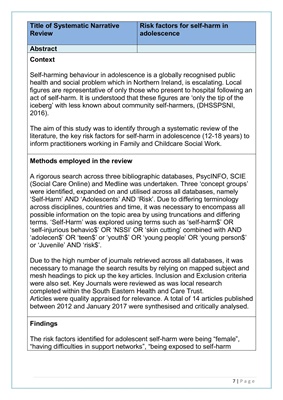
7 | P a g e
Title of Systematic Narrative
Review
Risk factors for self-harm in
adolescence
Abstract
Context
Self-harming behaviour in adolescence is a globally recognised public
health and social problem which in Northern Ireland, is escalating. Local
figures are representative of only those who present to hospital following an
act of self-harm. It is understood that these figures are 'only the tip of the
iceberg' with less known about community self-harmers, (DHSSPSNI,
2016).
The aim of this study was to identify through a systematic review of the
literature, the key risk factors for self-harm in adolescence (12-18 years) to
inform practitioners working in Family and Childcare Social Work.
Methods employed in the review
A rigorous search across three bibliographic databases, PsycINFO, SCIE
(Social Care Online) and Medline was undertaken. Three 'concept groups'
were identified, expanded on and utilised across all databases, namely
'Self-Harm' AND 'Adolescents' AND 'Risk'. Due to differing terminology
across disciplines, countries and time, it was necessary to encompass all
possible information on the topic area by using truncations and differing
terms. 'Self-Harm' was explored using terms such as 'self-harm$' OR
'self-injurious behavio$' OR 'NSSI' OR 'skin cutting' combined with AND
'adolecen$' OR 'teen$' or 'youth$' OR 'young people' OR 'young person$'
or 'Juvenile' AND 'risk$'.
Due to the high number of journals retrieved across all databases, it was
necessary to manage the search results by relying on mapped subject and
mesh headings to pick up the key articles. Inclusion and Exclusion criteria
were also set. Key Journals were reviewed as was local research
completed within the South Eastern Health and Care Trust.
Articles were quality appraised for relevance. A total of 14 articles published
between 2012 and January 2017 were synthesised and critically analysed.
Findings
The risk factors identified for adolescent self-harm were being "female",
"having difficulties in support networks", "being exposed to self-harm